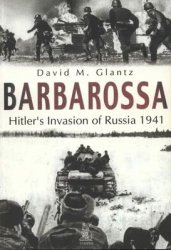
Название: Barbarossa: Hitler's Invasion of Russia 1941
Автор: David M. Glantz
Издательство: History Press Ltd
Год: 2001
Формат: PDF
Страниц: 256
Размер: 72,5 Mb
Язык: English
The sudden, deep and relentless advance of German forces during Operation Barbarossa has long fascinated military historians and general readers alike. Spearheaded by four powerful panzer groups and protected by an impenetrable curtain ofeffective air support, the seemingly invincible Wehrmacht advanced from the Soviet Union's western borders to the immediate outskirts of Leningrad, Moscow, and Rostov in the shockingly brief
period of less than six months. Historians have described the German advance as a veritable juggernaut; a series ofsuccessive offensives culminating in November 1941 with the dramatic but ill-fated attempt to capture Moscow. As described by Western military historians, the Barbarossa juggernaut began in June andJuly when the GermanArmy smashed Soviet border defences and advanced decisively and rapidly along the northwestern, western, and southwestern strategic axes. By early July German forces had shattered Soviet forward defences, encircled the bulk of three Soviet armies (the 3rd, 4th, and 10th) west ofMinsk, and thrust across the Western Dvina and Dnepr rivers, the Soviet's second strategic defence line. Once across the two key rivers, the panzer spearheads of German Army Groups North and Centre lunged deep into the Baltic region along the Leningrad axis and toward the key city ofSmolensk on the Moscow axis. To the south, Army Group South drove inexorably eastward toward Kiev against heavier Soviet resistance, while German and Rumanian forces soon invaded Moldavia and threatened the Soviet Black Sea port of Odessa.
During Operation Barbarossa's second stage in late July and early August, German Army Group North raced through Latvia into Estonia and Soviet territory south of Leningrad, captured the cities of Riga and Pskov and subsequently pushed northward toward Luga and Novgorod. Simultaneously, Army Group Centre began a month-long struggle for possession ofthe vital communication centre ofSmolensk on the direct road to Moscow. In heavy fighting, the army group partially encircled three Soviet armies (the 16th, 19th, and 20th) in the Smolensk region proper and fended off increasingly strong
and desperate Soviet counterattacks to relieve their forces beleaguered near the city. All the while, Army Group South drove eastward toward Kiev, destroyed two Soviet armies (the 6th and 12th) in the Uman' region southwest of Kiev, and blockaded Soviet forces in Odessa. This stage ended in late August, when Hitler decided to halt his direct thrusts on Leningrad and Moscow temporarily and, instead, attack and eliminate Soviet forces stubbornly defending Kiev and the central Ukraine.